You can easily dry fresh herbs for tea without a dehydrator by using air, oven, or microwave drying methods. For air drying, hang small bunches of herbs in a warm, dry area with good airflow. If you prefer oven drying, set your oven to the lowest temperature and spread herbs on a baking sheet, checking every 15 minutes. The microwave method is quick: simply place herbs on a paper towel and use low power in short bursts. Whichever method you choose, you'll preserve flavor and potency. There's even more to explore about storing and blending your dried herbs.
Benefits of Drying Herbs
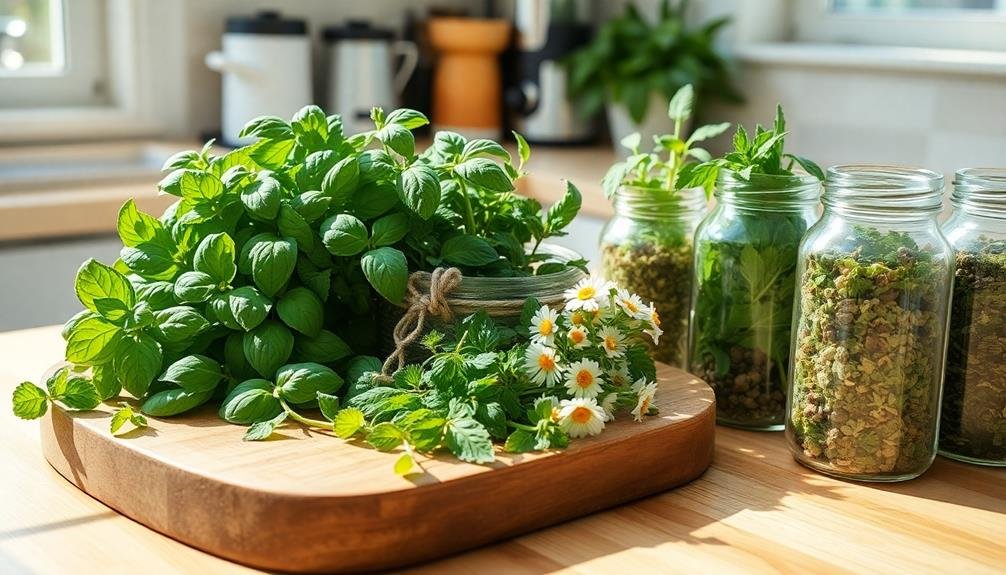
Drying herbs not only preserves their flavor but also enhances their shelf life, making it a practical choice for any tea enthusiast. When you dry herbs, you lock in their essential oils and vibrant taste, ensuring your teas burst with flavor long after the harvest season.
Fresh herbs can wilt and lose potency quickly, but dried ones maintain their unique characteristics, allowing you to enjoy your favorite blends year-round.
Moreover, drying herbs reduces spoilage and waste. Instead of tossing out wilted leaves, you can transform them into a delightful addition to your tea collection. You'll also save money, as purchasing dried herbs can be more expensive than drying your own.
Additionally, the act of drying herbs can be a rewarding experience. You'll connect with the ingredients you're using, appreciate their journey from garden to cup, and gain confidence in your herbal knowledge.
Plus, drying your herbs gives you control over the quality and freshness, ensuring you're sipping only the best. Ultimately, drying herbs enriches your tea-making experience, allowing you to create custom blends that reflect your tastes and preferences, all while enjoying the myriad benefits that come with it.
Choosing the Right Herbs
When it comes to choosing the right herbs for your tea, understanding their flavors and benefits is essential. Start by reflecting on your taste preferences. For a calming experience, chamomile offers a gentle sweetness, while peppermint delivers an invigorating kick.
If you're looking for something a bit more robust, try rosemary or thyme.
Next, think about the health advantages you want from your tea. For digestion, ginger can be a great choice, while hibiscus may help lower blood pressure. Each herb has its unique profile, so you can mix and match to suit your needs.
Don't forget to reflect on the aroma, too. The scent of herbs can notably enhance your tea-drinking experience. You might love the floral notes of lavender or the earthy tones of sage.
Methods for Air Drying
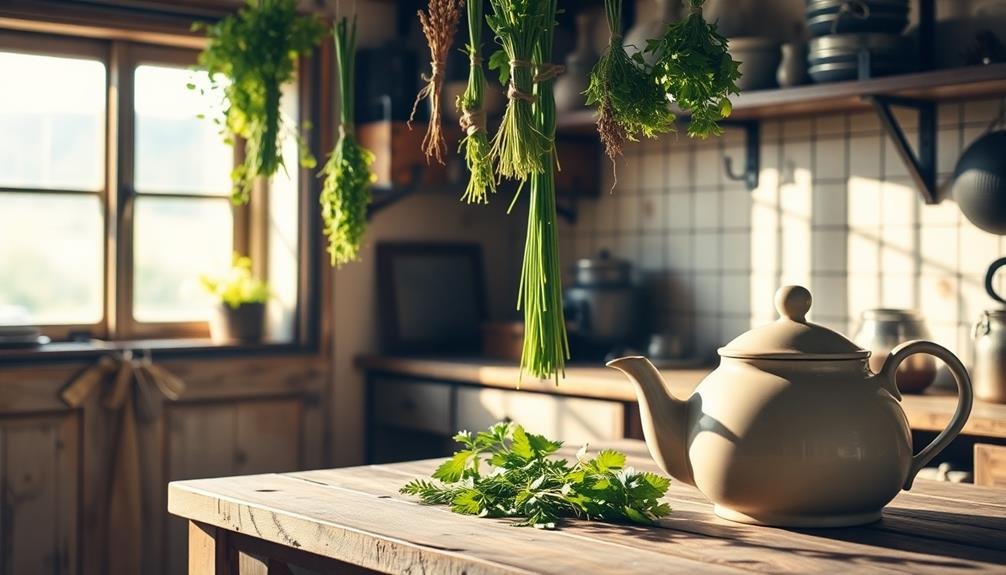
Now that you've chosen the right herbs, it's crucial to understand how to air dry them effectively.
You'll want to take into account ideal drying conditions like temperature and humidity to preserve the flavor and aroma.
Let's explore the best methods to guarantee your herbs are perfectly dried for tea.
Choosing the Right Herbs
Choosing the right herbs for air drying can greatly enhance your tea's flavor and aroma. Start by selecting herbs that are known for their drying properties. Popular choices include mint, chamomile, lemon balm, and thyme, as these herbs retain their flavors well after drying.
When you're choosing, opt for fresh, vibrant leaves without any signs of wilting or disease. Harvest your herbs in the morning after the dew has evaporated for peak flavor. This timing guarantees that the essential oils are at their most concentrated.
You'll want to pick the leaves just before the plants start to flower, as this is when their taste is most robust. Consider the flavor profiles you're aiming for in your tea. For example, if you prefer a invigorating and cooling effect, mint is your best bet. If you're looking for something more calming, chamomile is ideal.
Optimal Drying Conditions
To preserve the flavor and aroma of your freshly harvested herbs, it's important to create ideal drying conditions. Proper air drying can greatly enhance the quality of your dried herbs. Here are some key factors to take into account:
- Temperature: Aim for a warm, dry environment, ideally between 70°F and 90°F (21°C to 32°C). Avoid direct sunlight, as it can degrade essential oils.
- Humidity: Low humidity is vital. Make certain the air in your drying space isn't too damp, as this can lead to mold growth. A relative humidity of around 30-40% is best.
- Airflow: Good airflow is necessary for even drying. Think about using a fan to circulate air if your drying space is stagnant.
- Space: Give your herbs plenty of room. Hang them in small bunches or lay them out on a clean, dry surface to prevent them from sticking together.
Using an Oven for Drying
When you're ready to dry fresh herbs for tea, using an oven can be a quick and effective method. Start by preheating your oven to the lowest setting, usually around 170°F (77°C). This low temperature helps preserve the flavor and essential oils in your herbs.
Next, wash your herbs gently to remove any dirt or pests, then pat them dry with a clean towel. Arrange the herbs in a single layer on a baking sheet lined with parchment paper. Avoid overcrowding; this allows for even drying.
Place the baking sheet in the oven and leave the door slightly ajar. This helps moisture escape and prevents the herbs from cooking rather than drying. Check on them every 15 minutes. Depending on the herb's moisture content, drying can take anywhere from 30 minutes to an hour.
You'll know they're ready when the leaves crumble easily between your fingers. Once dried, let the herbs cool completely before storing them in airtight containers.
This method not only saves time but also guarantees you have your favorite herbs ready for delicious tea any time you want!
Microwave Drying Techniques
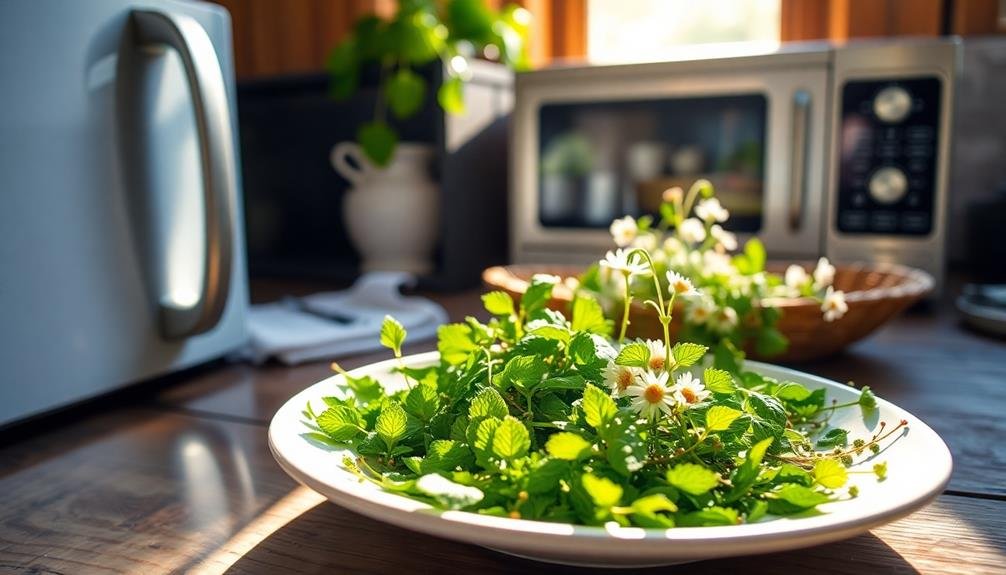
If you're looking for a quick way to dry fresh herbs, using a microwave can be a game changer.
You'll want to follow specific preparation steps and keep an eye on timing and temperature for the best results.
Once dried, proper storage is key to keeping those herbs flavorful for your teas.
Microwave Preparation Steps
Microwaving fresh herbs is a quick and efficient way to dry them for tea, and you'll love how it preserves their vibrant flavors. To get started, gather your fresh herbs and follow these simple preparation steps.
- Choose fresh herbs: Make certain they're clean and free from any wilting or browning.
- Rinse and dry: Gently rinse your herbs under cool water and pat them dry with a clean towel. This helps remove dirt and guarantees even drying.
- Trim and chop: Remove any tough stems and chop the herbs into smaller pieces to maximize surface area for drying.
- Arrange on a plate: Spread the herbs evenly on a microwave-safe plate lined with a paper towel. This will help absorb moisture during the drying process.
Once you've prepped your herbs, you're ready for the drying process. Microwaving isn't only fast but also retains the essential oils that give your tea its delightful aroma and taste.
Enjoy your freshly dried herbs in your next cup of tea, and savor the natural flavors you've preserved!
Timing and Temperature Tips
To guarantee your herbs dry perfectly, pay close attention to timing and temperature during the microwave process. Start by placing your fresh herbs on a microwave-safe plate lined with a paper towel. This helps absorb moisture and prevents sogginess.
Set your microwave to a low power setting—around 30% is ideal. High power can scorch your herbs and ruin their delicate flavors.
Microwave the herbs in short bursts of about 20 to 30 seconds. After each interval, check for dryness. You want the leaves to feel crisp but not burnt. Depending on the herb's moisture content, drying can take anywhere from one to five minutes. Remember, it's better to err on the side of caution, as you can always microwave them a bit more, but you can't undo over-drying.
If you notice any steam forming, pause the microwave and let the herbs cool for a moment before continuing. This prevents any residual moisture from affecting the drying process.
Once they're fully dried and cooled, you'll be ready to enjoy your homemade herbal tea!
Storing Dried Herbs Properly
Once your herbs are dried, proper storage is essential to maintain their flavor and potency. Without the right techniques, your hard work can quickly go to waste. Here are some tips to help you store your dried herbs effectively:
- Use airtight containers: Glass jars with tight-fitting lids or vacuum-sealed bags work best to keep moisture out.
- Keep them cool and dark: Store your containers in a pantry or cupboard away from heat and light, as these can degrade the herbs' quality.
- Label your jars: Clearly note the herb type and drying date on each container. This helps you keep track of freshness.
- Avoid crushing until use: Whole leaves retain their flavor longer than crushed ones. Crush just before use for maximum potency.
Proper Storage Solutions
Finding the right storage solutions for your dried herbs is essential to preserving their flavor and potency. Start by using airtight containers, like glass jars or metal tins, to keep moisture and air out.
Opt for dark-colored containers to limit light exposure, which can degrade your herbs over time. If you're using clear jars, store them in a dark cabinet or cupboard.
Keep your herbs in a cool, dry place away from heat sources, like stoves or sunny windows. Excess heat can diminish the essential oils that give your herbs their unique flavors.
Label your containers with the herb names and the date you dried them, so you can track their freshness.
Avoid storing herbs in the fridge or freezer; the humidity can lead to mold. Instead, take advantage of small vacuum-seal bags if you want to save space.
Just remember to only open them when you need to use the herbs to maintain their freshness.
Creating Herbal Tea Blends
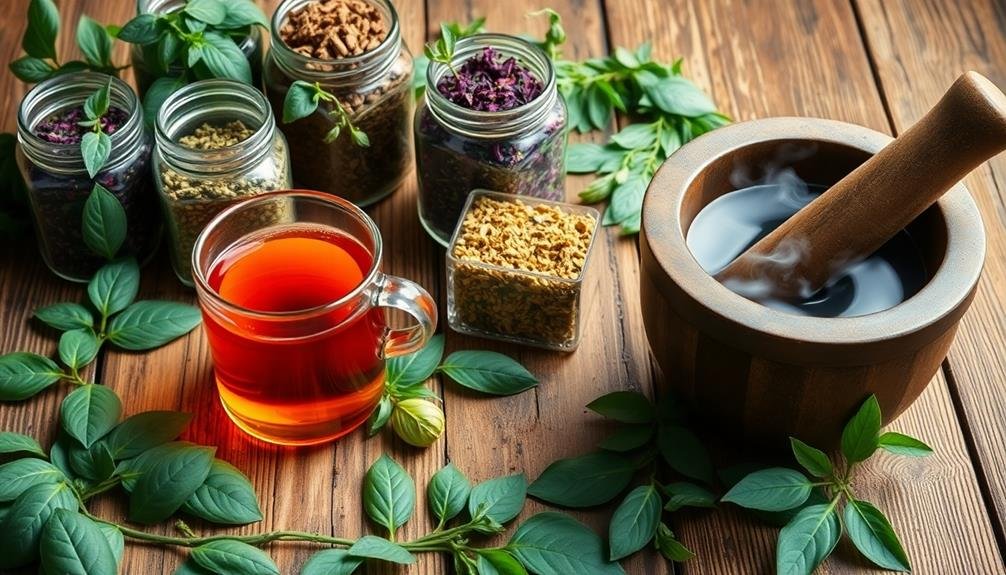
Crafting your own herbal tea blends can be a delightful and rewarding experience. You get to explore flavors, aromas, and health benefits that suit your taste and needs.
Start by selecting your base herbs, which can vary from calming chamomile to invigorating peppermint. Once you have your base, consider adding complementary herbs and spices to enhance the blend.
Here are some ideas to inspire your creations:
- Floral notes: Add dried lavender or hibiscus for a fragrant touch.
- Citrus zest: Include dried orange or lemon peel for a revitalizing zing.
- Sweet herbs: Incorporate stevia or licorice root for natural sweetness.
- Spicy elements: Try ginger or cinnamon for warmth and complexity.
Experiment with different combinations, and don't be afraid to adjust the ratios until you find the perfect balance.
Remember to keep track of your recipes, so you can recreate your favorite blends. Once you've crafted a few successful mixes, share them with friends or gift them in pretty jars.
Creating your own herbal tea blends not only enhances your tea experience but also allows you to enjoy the benefits of your favorite herbs.
Frequently Asked Questions
How Long Do Dried Herbs Last Before Losing Potency?
Dried herbs typically last about one to three years before losing potency. To guarantee freshness, store them in a cool, dark place, and check their aroma and flavor regularly. If they lose scent, it's time to replace them.
Can I Dry Herbs in Direct Sunlight?
You can dry herbs in direct sunlight, but it's best to avoid it. Sunlight can degrade their flavor and color, so consider a cooler, shaded area for better preservation of your herbs' qualities.
What Are the Signs of Mold on Dried Herbs?
When you check dried herbs, look for white or green spots, a fuzzy texture, or an off smell. If you notice any of these signs, it's best to discard the herbs immediately to avoid health risks.
Are There Any Safety Concerns With Drying Herbs at Home?
When drying herbs at home, you should guarantee proper cleanliness and ventilation. You'll want to avoid moisture buildup, which can lead to mold. Always check dried herbs for any signs of spoilage before using them.
Can I Use Dried Herbs for Cooking as Well?
Absolutely, you can use dried herbs for cooking! They add flavor and aroma to your dishes. Just remember, dried herbs are more concentrated, so you won't need as much compared to fresh ones. Enjoy experimenting!
In Summary
Drying fresh herbs for tea is a simple and rewarding process that doesn't require fancy equipment. By choosing the right herbs and using easy methods like air drying, oven, or microwave techniques, you can enjoy flavorful blends straight from your garden. Proper storage guarantees your herbs stay fresh longer, allowing you to savor your homemade herbal teas whenever you want. So, go ahead and experiment with your favorite herbs—you'll soon discover the delightful tastes you can create!

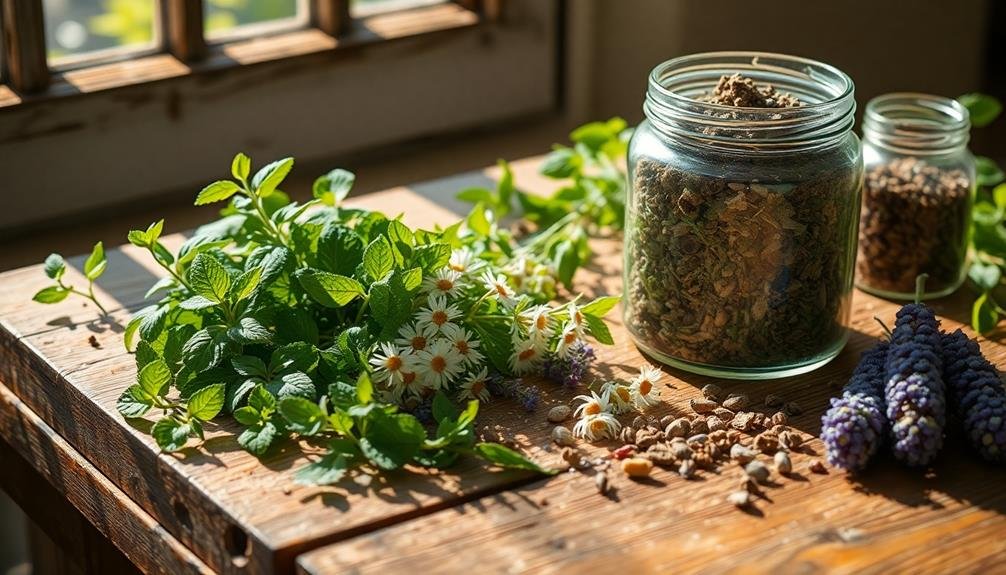



Leave a Reply